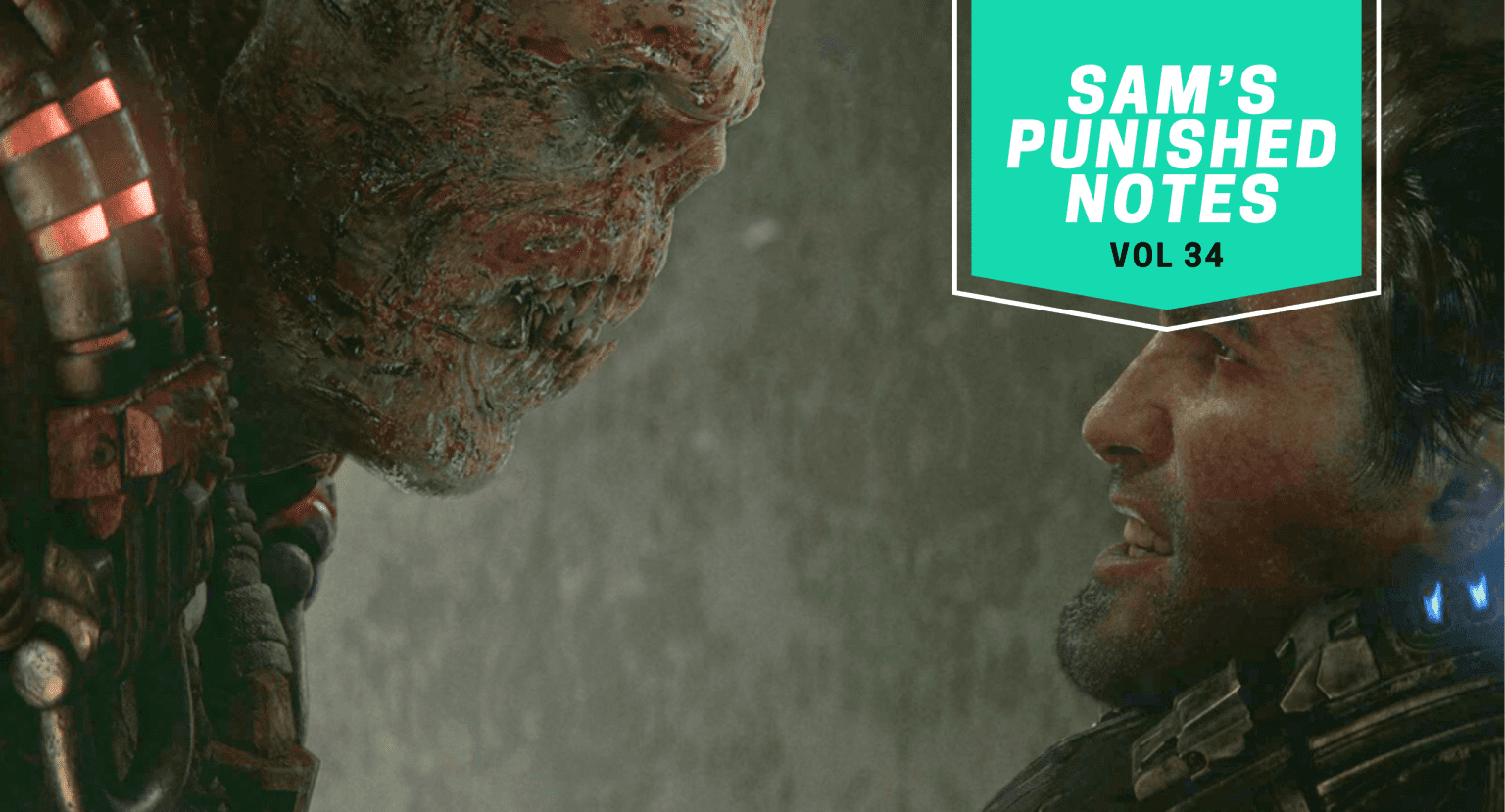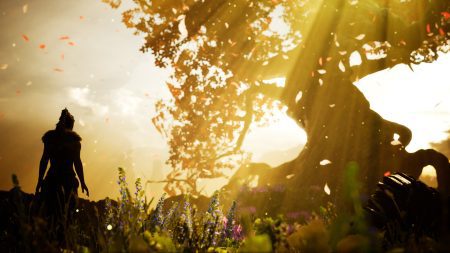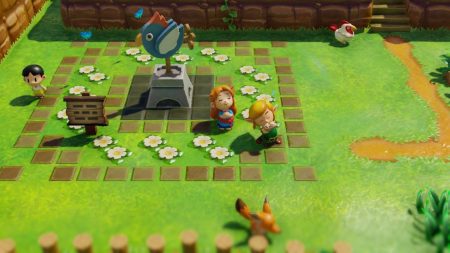Welcome back to Punished Notes! For this latest edition, volume 34, I discuss some of my feelings around the new Gears of War announcement, the one game that uses photorealistic graphics in creative ways, and, for some reason, Mean Girls. Also… plenty more in the lightning round!
I’m Conflicted About Gears of War: E-Day
Fairly or unfairly, I’ve garnered a reputation among some of my friends and fellow Punished Backlog writers as somewhat of an Xbox apologist. I don’t think every single Xbox console is the greatest thing since sliced bread—and I certainly can’t defend many of Microsoft’s indefensible and baffling actions—but I do generally enjoy Xbox’s first-party output more than most, even going so far as to largely favor it over PlayStation’s fake blockbuster approach.
Nowhere does this supposed apologia rear its head the most than in my staunch defense of 2019’s Gears 5, the fifth mainline entry in Xbox’s juggernaut Gears of War franchise. Unlike its predecessor, Gears of War 4, Gears 5 reinvigorated my love for the series, zeroing in on the slow-but-heavy action that defined its forefathers while adding in enough of its own flavor to stand out.
Most importantly, I fell in love with Kait Diaz, the game’s post-Act I protagonist, and her journey to learn more about the source of the deadly Swarm enemies, as well as her own family’s grisly past. Gears 5 felt fresh in so many ways, and I’ve been waiting five years for developer The Coalition to give me the next chapter in Kait’s story. So, when Microsoft closed its 2024 Xbox Games Showcase with a reveal trailer for Gears of War: E-Day, a prequel to the first game in the series, let’s just say I had a fairly mixed reaction.

Let’s first consider the positives. I love the idea of playing as a young Marcus Fenix (the protagonist of the first three games) learning to grapple with the first days of the invasion of the Locust (alien bug people that live beneath the planet’s surface). Fenix and his squadmates are grizzled, veteran badasses at the start of the first Gears of War, so seeing these men face a horrifying, unimaginable new threat appeals to the fan in me.
Meanwhile, the folks over at The Coalition seem to appreciate what made the original games so successful in the first place, and are seeking to reinvigorate the franchise’s fanbase by boiling everything down to the fundamentals.
“We realized that a lot of the words we use to describe the franchise were what our fans also use, phrases like brotherhood, brutality, pathos, awe,” said creative director Matt Searcy in an interview with Xbox Wire. “Why E-Day? That’s the moment it all comes together. It’s the heart of the Gears universe. Everything that happens is shaped by this day.” What Gears lover wouldn’t want that?
My concerns, however, are twofold. First of all, I thoroughly enjoyed the ways Gears 5 pushed the franchise to new narrative realms without completely abandoning what made people fall in love in the first place. The series’ transition away from the Fenix family toward Kait Diaz, a Latina woman with familial ties to Locust Queen Myrrah, allowed the player to finally inhabit someone other than a grotesquely muscular white guy.
Diaz’s character arc (which, if I’m being honest, was a little messy) got to exist outside of the typical “traumatized war hero” archetype that has plagued video games for decades, and as a result the structure of the campaign got to explore various themes only hinted at but not fully explored in previous entries: the individual vs. the collective, what it means to fight on behalf of the lesser evil, whether survival means anything after so much loss, and whether one can truly distance themselves from their familial past. Delaying a follow-up to Gears 5 means avoiding a satisfying conclusion to Kait’s story for even longer.
Secondly, while I understand the “back to basics” approach a lot of companies take when rebooting or returning to a familiar IP, such a decision could potentially pull the series backward. Instead of trying to build upon what came before, The Coalition seems to be retreating to the franchise’s comfort zone. I love the original Gears of War trilogy as much as anyone, but I can always go back and play those old games; I was ready to move on after 2011, and I remain ready to see what else the world of Sera has in store. You can’t grow an IP by just doing the same thing over and over again.
I know I’ll play (and probably enjoy) E-Day when it comes out, whenever that is. The Coalition will probably nail the gameplay mechanics and present a compelling story with a nice balance of new ideas and fan service moments. Most Gears enthusiasts will likely fall in love with the characters and locales all over again. I just think Kait Diaz deserves more, and so do we.

Hellblade II and Making Better Graphics Actually Matter
While I continue to be impressed by the gradual improvement of ultra-realism in video game visuals over the years, such improvements are rarely that massive (or even particularly noticeable to the naked eye) anymore. Even when such strides in visual technology do stick out, I no longer feel quite as amazed by them as I used to. Moreover, I yearn for times in gaming when such limitations in graphical fidelity inspired developers to try more visually creative routes, such as Dishonored’s jagged comic-book feel or the insane body proportions of the characters in Gears of War.
Senua’s Saga: Hellblade II, Ninja Theory’s latest epic Norse tale, offers particularly noticeable leaps with its presentation, and it’s genuinely incredible from a technical standpoint, both visually and sonically (seriously, the audio effects in this game are outstanding). Unlike most other AAA titles with similarly impressive graphics, however, Hellblade II goes a step further, utilizing such advancements to enhance the game’s narrative elements.
A sequel to 2017’s Hellblade: Senua’s Sacrifice, Hellblade II continues the story of Senua, a Pict warrior from Orkney in the early ninth century who allows herself to be captured by Northmen slavers and taken to Iceland in an attempt to free her enslaved people. The titular hero must navigate through a bevy of trying obstacles, battling giants and draugar (evil baddies from Norse folklore) left and right while braving her way through the elements just to survive.
Those familiar with the first game understand a notable twist: Senua has psychosis (characterized as her “curse”), meaning she constantly hears competing voices only in her head, and it’s difficult for her to discern whether every horror she sees is real or imagined.
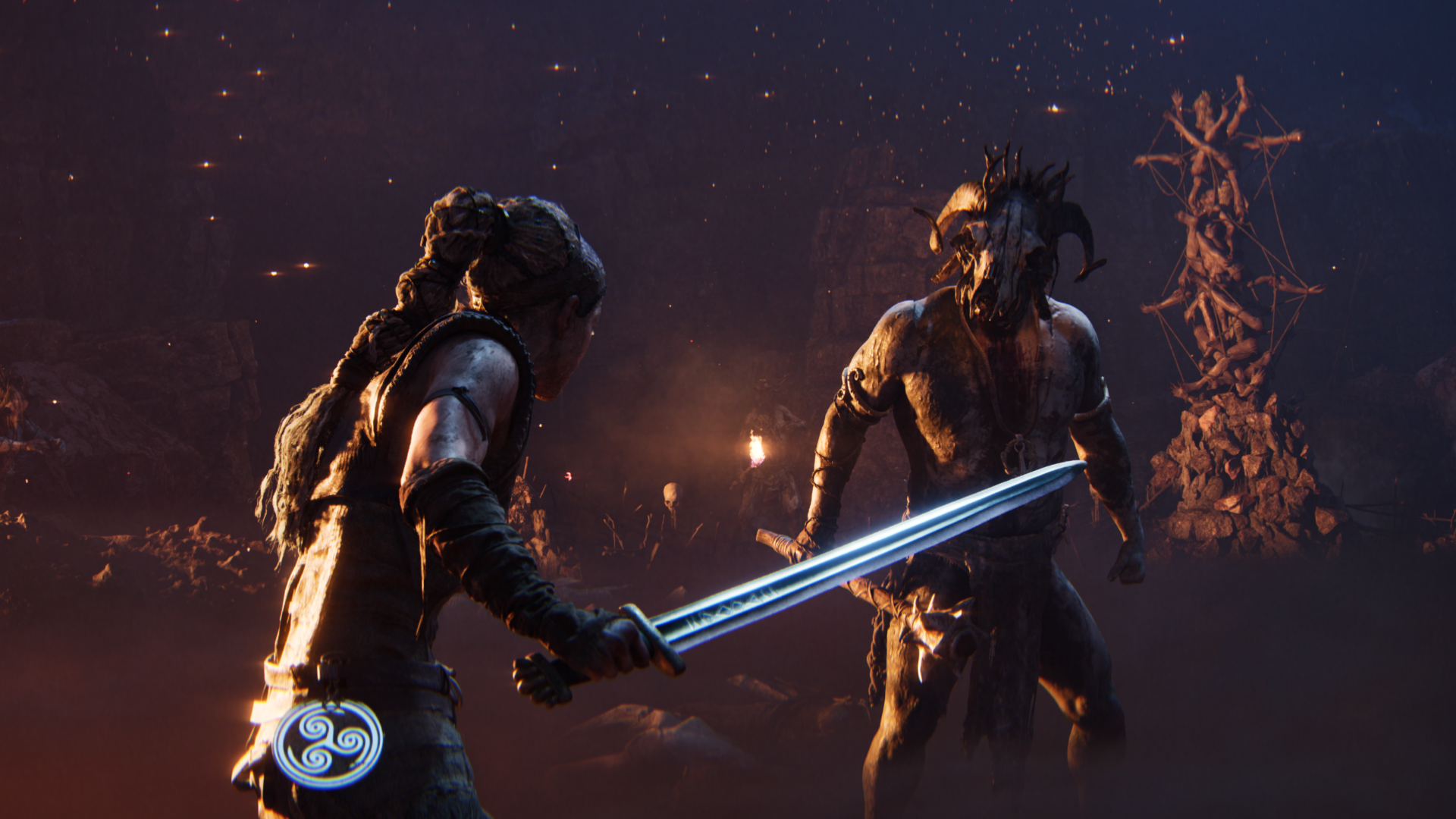
I can’t speak to the accuracy of either Hellblade title’s depiction of this kind of mental illness—there has been some debate over this, after all—but the way Senua’s Saga plays with such hallucinations makes the more realistic graphics truly essential to the overall experience. The player can easily identify grass, rocks, water, and trees, but the monsters and glowing orbs seem just as natural. Sword fights with the draugar only appear marginally different than similar skirmishes with humans, especially in the dark. If everything looks equally real to the player, shouldn’t it be the same for Senua?
The game expertly presents phenomena that seem fantastical and outlandish while providing cogent explanations for why people might find them real (e.g., religious fanaticism, misinterpreting natural disasters, the fog of war). So when Senua, struggling as she always has to maintain a grip on her own sanity, witnesses a giant emerging from lava, of course she would think it’s actually happening, since others around her also believe such a thing is possible. As a result, the player can’t always be sure how much of the game is real or fantasy. For once, having everything look nearly real actually made me question how much a video game character’s own personal experience was fantasy.
For the most part, I still vastly prefer a diversity of art direction among AAA games over what we’re currently seeing, where a lot of games are starting to look more and more alike. But if other studios took the same approach that Ninja Theory just did, I’d understand it and possibly even encourage it. (Probably not, though, since such slavish devotion to graphical fidelity is probably harming the industry at large more than most realize.)

LIGHTNING ROUND!!!!!!!!!!!!!!!!!!!!!!!!!!!!!!!!!!
- Another quick note on Hellblade II: The game’s simplistic, 1-vs-1 approach to combat works greatly to its benefit. Some of the fights in the first Hellblade, particularly ones where you had to battle multiple opponents at once, were too chaotic and frustrating, whereas basically every encounter in the sequel feels relatively smooth and exciting.
- I’m still chugging along with Dragon Quest VIII, and the funny thing about this game is that I would argue that while it “gets good” about 25 hours in (especially after a particular story twist occurs), the prior 25 hours are still… quite good. It may seem bizarre to praise anything that takes so long to feel worth it, but for some reason I don’t think such a view detracts from the previous 25 hours at all. The game is fantastic in its entirety, but I’m especially glad it manages to have new gears it can reach that far into the experience.
- The best part of last month’s Nintendo Direct wasn’t any single announcement (though, to be clear, I am extremely hyped for games like The Legend of Zelda: Echoes of Wisdom, Dragon Quest III HD-2D Remake, and Metroid Prime 4: Beyond). Instead, the presentation’s greatest aspect was that it got people excited once again about a console that’s over seven years old. Basically everyone I knew saw at least one game—or even two or three—during that Direct that they can’t wait to play, and that’s not something I can say about any other Nintendo platform that late in its lifespan.
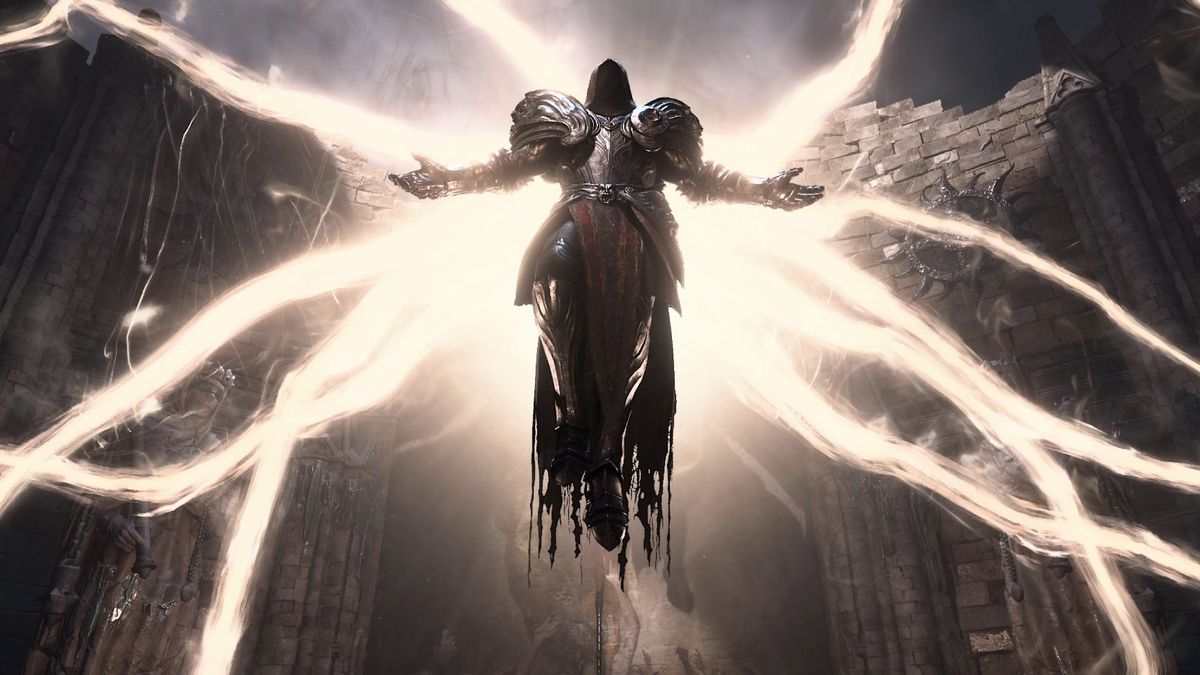
- I finally got around to playing Diablo IV recently, and while I’m certainly having a good time, it might be the most polished one-note game I’ve played in years. Sure, the way you build your character and the strategies you employ can go in any number of directions—which is the whole point of an RPG, I suppose—but in my roughly dozen hours of playtime, I’ve done the same handful of actions hundreds of times. There’s absolutely nothing inherently wrong with this, but I do wonder if I’ll tire of it sooner rather than later.
- The Switch of Paper Mario: The Thousand-Year Door is great so far (I never played the GameCube original), but I hesitate at this time to call it the best Mario RPG ever made. I still would give the edge to Super Mario RPG or even, in some ways, Mario & Luigi: Superstar Saga.
- As much as I love Elden Ring, I don’t think I’ll ever get to the Shadow of the Erdtree expansion. In addition to not being able to play it even if I wanted to (I still haven’t defeated Mohg, which is a prerequisite for the DLC), I just think my Elden Ring experience was great enough as it was. I accomplished all I needed to, and feel little motivation to go any further.
- I also decided to replay the original Gears of War recently after seeing the E-Day trailer, and it occurred to me that this franchise has a particularly difficult needle to thread with every new release; the first game is so well crafted mechanically that changing too much of it risks making everything feel worse. Epic Games really cooked with the first Gears of War, whose actual movement and shooting mechanics remain nearly perfect to this day. As fair as it is to criticize any franchise for not innovating enough, it makes sense when you nailed it right away.
- On a recent flight, I decided to watch Mean Girls (2024), a movie adapted from a Broadway musical that was inspired by a movie (yes, you read that right). The original Mean Girls is iconic in so many ways, has some of the best writing of any high school movie of my lifetime, and captured a lot of the anxieties around teen social dynamics in the early 2000s. This new one has its positives (Renee Rapp and Auli’i Cravalho are both phenomenally talented) but feels like it exists in two different eras at once: modern times, where everyone has smartphones and TikTok, and the early 2000s, when nobody had any of these things. It doesn’t quite strike a tonal balance between those two eras, and as a result feels incoherent and unnecessary. At least the songs were also bad.
Sam has been playing video games since his earliest years and has been writing about them since 2016. He’s a big fan of Nintendo games and complaining about The Last of Us Part II. You either agree wholeheartedly with his opinions or despise them. There is no in between.
A lifelong New Yorker, Sam views gaming as far more than a silly little pastime, and hopes though critical analysis and in-depth reviews to better understand the medium's artistic merit.
Twitter: @sam_martinelli.


